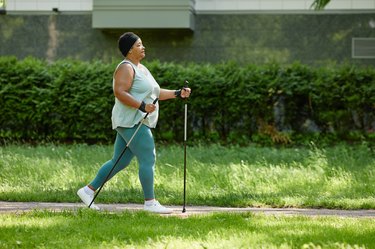
Appendicitis is a painful condition that can develop suddenly and often requires surgery (an appendectomy), per the Cleveland Clinic. And while exercise probably isn't your top concern during recovery, if you were active before, you may have difficulty adapting to life after illness and/or surgery.
Appendicitis can greatly limit your motion and use of your abdominal muscles. If you didn't require an appendectomy, chances are that you'll be able to return to exercise as soon as the inflammation decreases and your doctor gives you the OK.
Video of the Day
Video of the Day
If you did have surgery, though, slowly building up your physical activity, especially abdominal exercises, will help you increase strength without causing complications.
The best exercises after appendicitis are designed to help return your body to its healthy physical state and improve range of motion in limbs that may have slight atrophy during your illness.
Strengthening the muscles of the core may also help in your recovery by quickening your return to an active lifestyle, but you need to be careful to avoid injury. Here's what you need to know to return to exercise safely.
Tip
Exercising after appendicitis might be possible soon after recovery, or it could be delayed — particularly if you require surgery. Check with your doctor or surgeon for specific instructions about exercise after appendectomy.
Post-Surgery Bed Exercises
If you've recently had an appendectomy, chances are you'll be in bed for an extended period of time as your body heals. But once you start to feel up to it, there are a few gentle movements you can do in bed, as long as your doctor approves.
New York Presbyterian Hospital recommends starting off with basic leg pumps and lifts to help improve blood flow and circulation in the lower portions of your body.
1. Leg Pumps
- Lying in bed on your back, squeeze your quad muscles (front of your thighs).
- Hold for 1 to 5 seconds as your endurance allows.
- Repeat 5 to 10 times.
- If you're feeling strong enough, think about lifting your legs off the bed (without actually lifting them) to engage your glutes and abdominals as well.
2. Ankle Pumps
- Lying in bed on your back, flex your ankle so that your toes point toward the ceiling (or slightly further back if your mobility allows).
- Focus on squeezing the muscles in your shin.
- Next, point your toes as much as you can while gently squeezing your calf muscles.
- Repeat this cycle 5 to 10 times.
3. Leg Lifts
- Lying in bed on your back, bend your right knee and slide your right foot along the bed up toward your butt. Stop when your right foot reaches your left knee.
- During this movement, focus on using your hamstrings (back of your thigh) and engaging the lower portion of your abdominals without putting too much strain on them. (Don't bear down or forcefully exhale.)
- Slide your foot back to meet the other.
- Repeat 3 to 5 times on this leg before switching legs.
Performing bed exercises can also help reduce the risk of blood clots in your lower extremities. Aim to do these exercises every hour while in bed.
Once you're strong enough to sit up on your own, you can perform seated knee lifts from the edge of you bed.
4. Seated Knee Lifts
- Sit on the edge of a chair or bed and steady yourself with your hands.
- Slowly lift one leg at a time, with your knees bent.
- Repeat this 12 to 15 times on each leg.
- As you gain more strength, progress to lifting both legs simultaneously. The motion doesn't have to be big to be effective.
Related Reading
Take Short Walks
After 10 to 14 days of relative inactivity during your recovery, it's usually safe to begin performing basic exercises and light physical activity. According to the Mayo Clinic, you should begin your post-appendicitis exercise regimen with short walks.
During these walks, be aware of your walking form and posture. Focus on lightly engaging your abdominal muscles without straining, bearing down or moving your torso in any direction. The goal should be to rebuild strength to achieve proper posture.
Stop walking as soon as you feel fatigued and don't push yourself to exercise for extended periods of time.
Gentle Abdominal Exercise
After several weeks of recovery, perform gentle abdominal strengthening exercises to begin rebuilding your muscles.
- Start by sitting down on the edge of a bed with your feet hanging off the edge of the bed.
- With your back straight and core tightened, slowly lift up your legs until they're parallel with the floor.
- Hold this position for several seconds before slowly lowering your legs back to their original position.
- Repeat until fatigued.
Can You Do Sit-Ups After Appendicitis?
The Mayo Clinic recommends avoiding any strenuous activities for five days following a laparoscopic appendectomy and 14 days after an open surgery. At that point, you should discuss your activities with your doctor, but it's generally safe to begin light exercise.
Sit-ups, however, are too strenuous and repetitive to perform following surgery, but other activities can be performed.
Related Reading
Swimming and Recovery
Swimming is a low-impact exercise that puts minimal amounts of stress on your joints. Check with your surgeon before swimming to make sure it's safe to get your incision wet. This activity can typically be started two to three weeks after surgery.
After recovering from appendicitis, start with short laps, using a freestyle swim technique to put less strain on your abdominal muscles. Stop swimming as soon as you feel tension or pain in your lower abdominal region. As your strength returns, increase the number of laps you do and vary the strokes you perform.